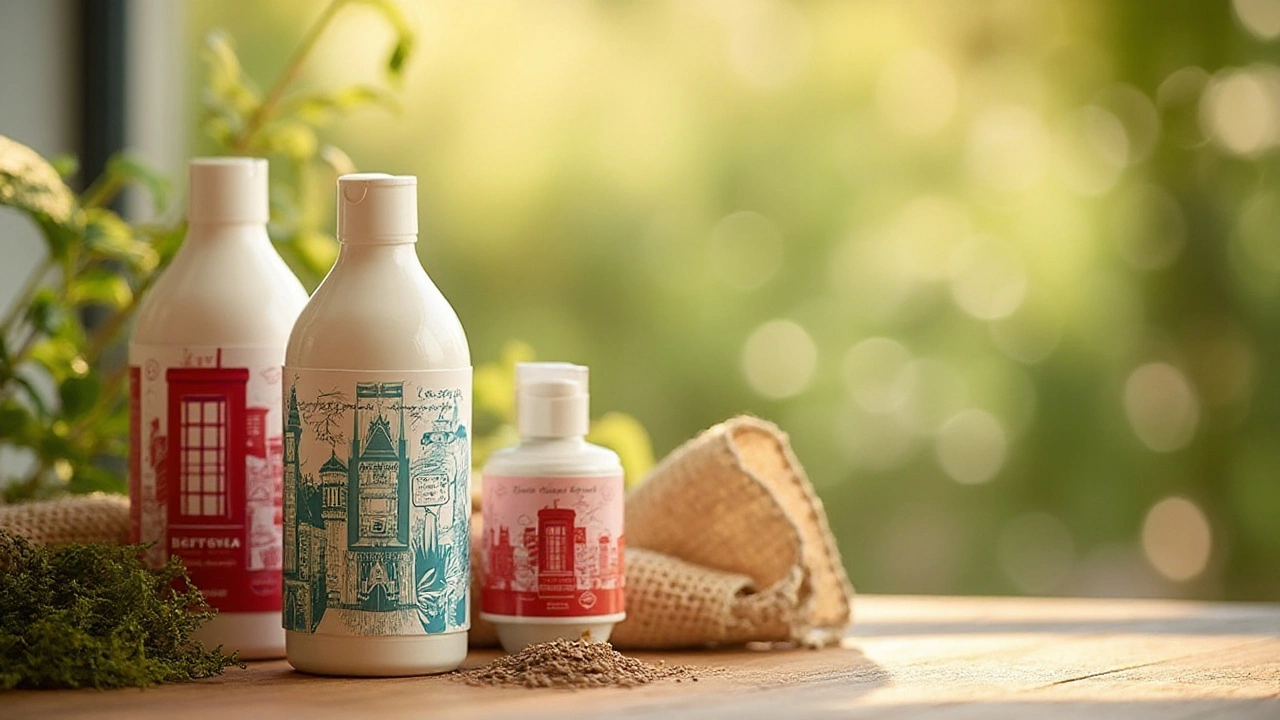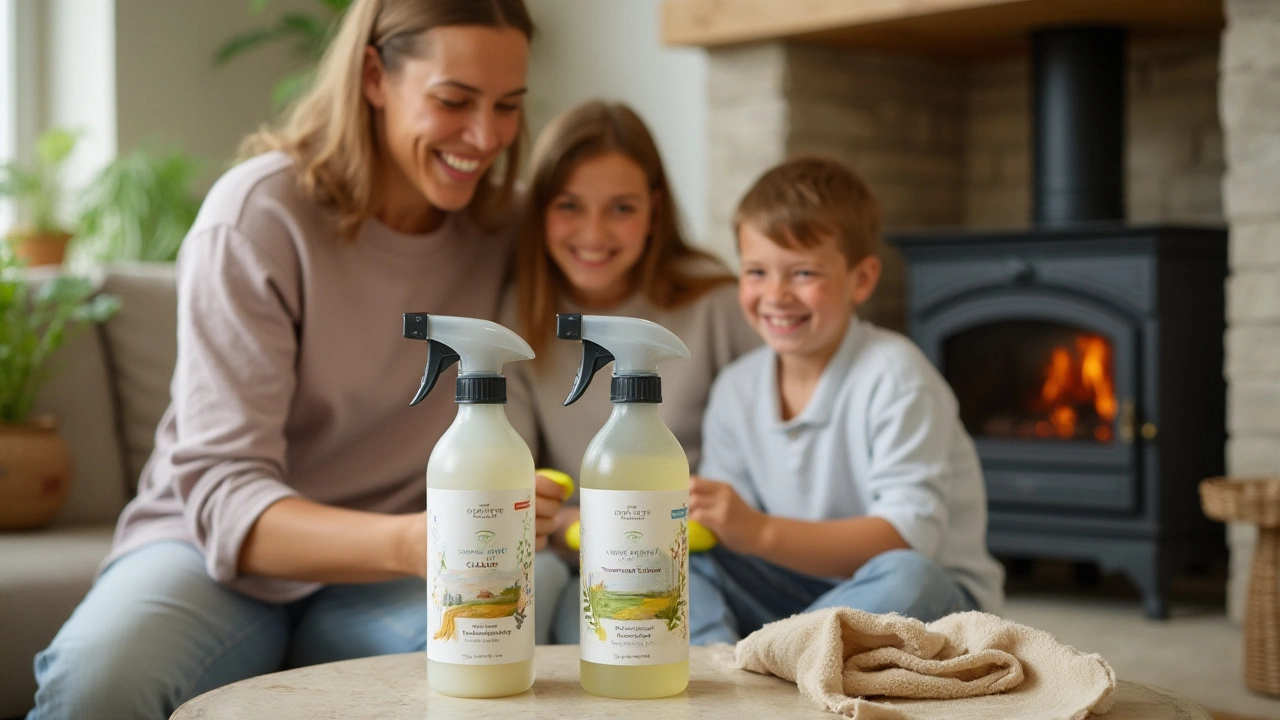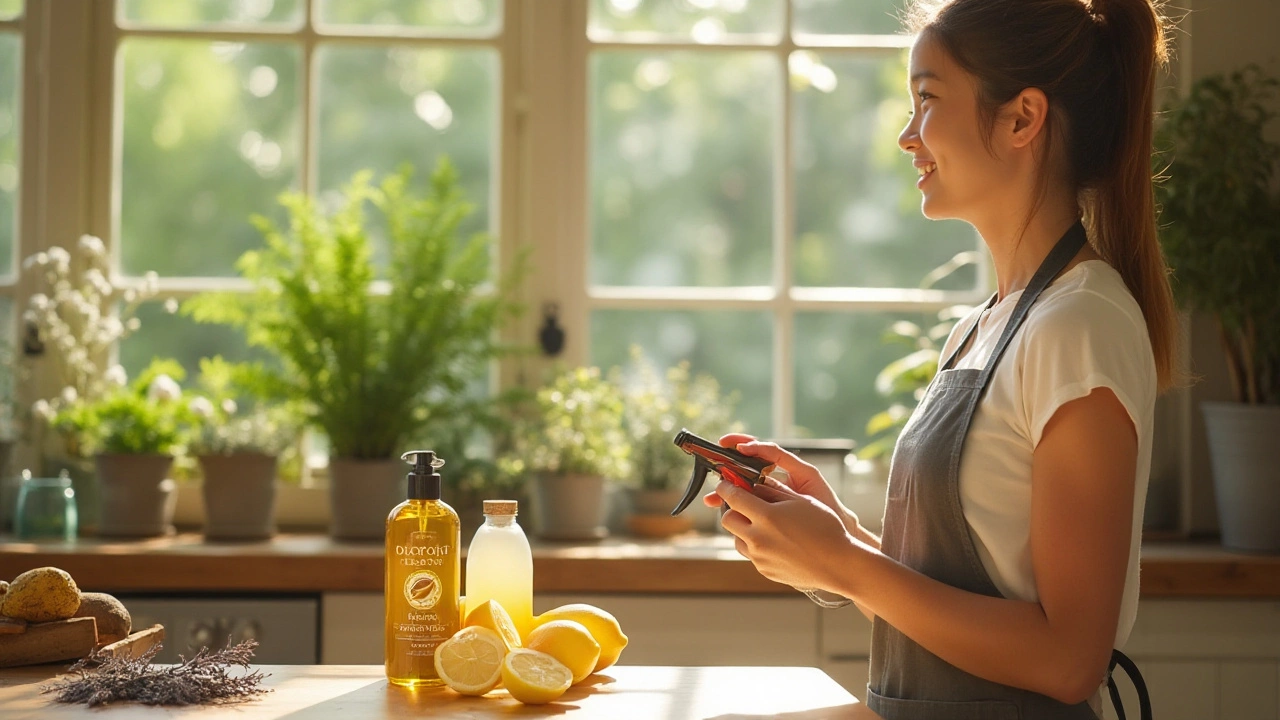In recent years, the demand for eco-friendly cleaning agents has surged as people become more aware of their impact on the environment. These products offer a sustainable alternative to conventional cleaning agents by minimizing harmful chemicals and embracing natural ingredients.
Eco-friendly cleaning agents are not only beneficial for our planet but also for our homes. By choosing cleaners made with simple, non-toxic materials, we protect our health and that of our loved ones. Furthermore, these products often come with the bonus of eco-conscious packaging, reducing our overall carbon footprint.
As consumers, it is crucial to understand the true nature of these products to make informed choices. Knowing what makes a cleaning agent eco-friendly can help us steer clear of greenwashing and ensure we are contributing to a greener, cleaner world.
- Definition of Eco-Friendly Cleaning Agents
- Common Ingredients in Green Cleaning Products
- Benefits of Using Eco-Friendly Cleaners
- How to Identify Truly Eco-Friendly Products
- DIY Eco-Friendly Cleaning Solutions
- Impact on Health and Environment
Definition of Eco-Friendly Cleaning Agents
Eco-friendly cleaning agents have become a topic of significant interest as individuals worldwide seek to live more sustainably. At their core, these agents are formulated to perform cleaning tasks without releasing harmful substances into the environment or human bodies. The essence of what makes a cleaning product truly 'eco-friendly' includes the combination of readily biodegradable ingredients, low toxicity to aquatic life, and minimal volatile organic compound (VOC) emissions.
The notion of using natural products isn't exactly new. In fact, history tells us that our ancestors once relied on nature-derived substances to maintain hygiene. What differentiates today's eco-friendly products from those of yesteryear is the conscious innovation to ensure they meet modern standards of efficacy while steering clear of petrochemicals. Many such products proudly avoid phosphates, which are notorious for damaging aquatic ecosystems.
When it comes to identifying suitable natural products, certain certifications and labels, such as the European Eco-label or the Ecocert certification, can offer guidance. These certifications mean the product adheres to specific environmental criteria. Such labels check whether a detergent contains renewable plant-based ingredients, has a controlled use of surfactants, and uses environmentally friendly packaging. Indeed, using these purchasing guides, discerning shoppers can feel confident that their chosen green cleaning product aligns with their sustainability goals.
"Green cleaning is about a new day, a fresh start and a healthier environment for those who work there, as well as those who call it home," says Stephen Ashkin, often considered the father of the green cleaning movement.
An interesting point to consider is that many eco-friendly cleaning agents leverage essential oils such as eucalyptus or tea tree, which not only aid in cleaning but also have natural antibacterial properties. This multifunctional aspect allows consumers to declutter their cabinets, as fewer products are necessary for comprehensive home hygiene. Among the many virtues of using sustainable cleaning products, one often overlooked is the reduced risk of allergic reactions and skin sensitivity, making them particularly beneficial for individuals with health concerns.
So next time you are in the cleaning aisle, look for the product's ingredient list. Can you recognize the names? A good rule of thumb is transparency; the more transparent a product is about its content, the more likely it is to be truly eco-friendly. It's about making smarter choices that benefit not just us, but also the larger world we inhabit.
Common Ingredients in Green Cleaning Products
When it comes to making a clean and environmentally friendly choice, knowing what goes into your cleaners is key. Eco-friendly cleaning agents often boast ingredients that are not only gentle on nature but also effective at tackling dirt and grime. Among the usual suspects in these green concoctions is vinegar. This versatile liquid is famous for its ability to cut through grease and grime while killing some bacteria and germs. What's more, vinegar is both cheap and widely available, making it a staple in many DIY cleaning recipes.
Baking soda is another common player in the green cleaning scene. Not only is this white powder a natural deodorizer, but it also acts as a mild abrasive, making it perfect for scrubbing away tough stains without the harshness of chemical abrasives. Whether you’re dealing with kitchen countertops or bathroom tiles, baking soda can be a useful ally. Paired with vinegar, it can create a fizzing action that helps lift away stubborn spots.
Essential oils have been making waves in the world of green cleaning as well. They bring not only delightful aromas to your cleaning routine but also possess natural antibacterial properties. For instance, tea tree oil is well-regarded for its ability to fight bacteria, viruses, and fungi. Lemon and lavender oils are also favorites, known for their pleasant scents and cleansing power. However, it’s wise to use them sparingly, as a little goes a long way.
Olive oil is an ingredient that may surprise many. Known more for its culinary uses, olive oil can also serve as a base for furniture polishes, giving wood surfaces a shine and protective layer without synthetic chemicals. Similarly, castile soap, which is derived from vegetable oils, provides a biodegradable and eco-friendly option as a general cleaner. Unlike traditional soaps, castile soap is free from animal fats and synthetic detergents, making it a compassionate choice for the mindful cleaner.
An interesting aspect of these natural products is their multifunctionality. For example, a simple mix of water and castile soap can clean almost anything from laundry to floors. To illustrate this, a study published in the Journal of Environmental Health found that using eco-friendly cleaning products significantly reduced indoor air pollution, creating a healthier environment for inhabitants. The versatility and safety of these ingredients mean fewer products cluttering your cupboards, reducing waste and simplifying your cleaning arsenal.
For those who care not just about green practices but also about the visual appeal of their products, green labeling often emphasizes biodegradable packaging. It’s common to find products wrapped in recycled or renewable resources, reducing their environmental impact. By understanding the ingredients in sustainable cleaning products, consumers can make informed decisions that benefit the environment and their households, all while maintaining the sparkling cleanliness they desire.

Benefits of Using Eco-Friendly Cleaners
When you opt for eco-friendly cleaning methods, you are making a conscious choice to keep both your home and the planet a cleaner, healthier place. One of the primary benefits is the significant reduction in exposure to harmful chemicals. Many conventional cleaning agents contain substances like ammonia, bleach, and phosphates that can irritate the lungs, skin, and eyes. Over time, these chemicals can even contribute to chronic health issues. Switching to green products, made from natural ingredients such as vinegar, lemon juice, and essential oils, can help you avoid these risks and promote a safer home environment.
Another noteworthy advantage is the positive impact on indoor air quality. Volatile organic compounds (VOCs) present in traditional cleaning products can decrease indoor air quality, leading to respiratory problems and other health concerns. Eco-friendly cleaners are typically low in VOCs or completely free from them, allowing your family to breathe easier and stay healthier. This improvement is especially crucial for households with children, the elderly, or anyone with asthma or other respiratory issues.
Grandly, embracing sustainable cleaning initiatives also supports environmental conservation. Conventional cleaning agents often end up rinsed down the drains, where they can pollute waterways and harm aquatic life. Eco-conscious products, on the other hand, are biodegradable and designed to break down naturally without leaving harmful residues behind. This ensures that water sources remain untainted and safe for wildlife.
"The Environmental Protection Agency (EPA) notes that choosing products with safer ingredients is a critical step toward protecting our natural resources," explains environmental scientist Dr. Lisa Carpenter.
Surprisingly, many people don't realize the economic savings linked with natural products. Although certain eco-friendly brands may have a slightly higher upfront cost, their effectiveness often means you use less product over time. Some households even find cost-efficiency by creating their own cleaning solutions with affordable pantry staples. Additionally, by extending the life of household items through gentle cleaning methods, you save money in the long run, avoiding the need to replace damaged goods.
By choosing sustainable cleaning options, you set a precedent for ethical consumerism, likely inspiring friends and family to follow suit. This collective action contributes to larger-scale positive environmental change, showcasing the ripple effect of personal choices. It encourages companies to prioritize sustainability in their operations, packaging, and product lines, driving industry-wide shifts toward greener practices.
Summarily, the shift to green cleaning is not only a personal health decision but also a commitment to environmental stewardship. With every non-toxic spritz and scrub, you're investing in a healthier world, now and for future generations. Whether it's through improved health outcomes, environmental protection, or economic savings, the benefits of these choices are both personal and profound.
How to Identify Truly Eco-Friendly Products
Identifying truly eco-friendly cleaning products can be a bit daunting with the vast number of brands claiming to be 'green.' To make an informed choice, it's important to look beyond the marketing buzzwords. The first step is examining the product's ingredient list. Many traditional cleaning products contain harsh chemicals that can be harmful to both the environment and your health. Conversely, eco-friendly products make use of natural ingredients such as vinegar, baking soda, and essential oils. Look for products that explicitly list their ingredients on the packaging—as transparency often indicates reliability.
Another substantial clue to a product's eco-friendliness is its certifications. Reliable certifications from organizations like EcoLogo, Green Seal, and the U.S. Environmental Protection Agency's Safer Choice can guide you in selecting authentic green products. These certifications require that products meet stringent environmental and health standards, ensuring they perform effectively without compromising essential safety. Additionally, paying attention to packaging can also provide insights. Products packaged in recycled materials or with minimalist designs tend to align with sustainable practices.
Manufacturers who are truly committed to sustainability often go beyond just the products themselves. Many engage in ethical practices such as using renewable energy in production, supporting fair trade, or contributing to environmental charity projects. An excellent indicator of an authentic eco-friendly brand is their outreach and educational efforts towards a healthier planet. Reading customer reviews can be revealing as well. Genuine experiences and insights around product efficacy and eco-friendliness can greatly aid in your purchasing decisions.
In the realm of green cleaning, it's not uncommon to encounter brands that partake in 'greenwashing,' a practice where products are marketed as more environmentally friendly than they truly are. A 2010 study conducted by TerraChoice found that 95% of products marketed as green were guilty of some form of greenwashing, a practice that can mislead consumers. Steer clear of vague labels that claim terms like 'natural' or 'eco-friendly' without backing up these claims with evidence.
Engaging with social media communities focused on green living can also provide valuable insights allowing you to learn from like-minded individuals' experiences. And, when in doubt, you can always craft your own cleaning products. Household staples like lemon, vinegar, or baking soda can be surprisingly effective and genuinely sustainable cleaning agents, cutting down on your need to rely on store-bought alternatives.
"Green cleaning products are an essential part of a sustainable lifestyle", says Christine Neville, Head of Sustainability at Clean Green Solutions. "By increasing demand for these products, we push manufacturers to prioritize the health of our planet alongside profit."
This approach not only ensures you're using products that are safe for the environment, but it can also be a rewarding experience in itself, providing peace of mind with each eco-conscious choice you make and supporting a sustainable ecosystem in the long run.

DIY Eco-Friendly Cleaning Solutions
There is a growing interest in eco-friendly cleaning solutions that you can make right at home. Not only do these DIY cleaners reduce the need for harsh chemicals, but they also put recycling and resourcefulness at the forefront. It all begins with a few basic ingredients that can often be found in your pantry. Think vinegar, baking soda, lemon juice, and essential oils. These natural components are remarkable for their cleaning power and ability to sanitize effectively without leaving toxic residue. Paired with the right knowledge, you can transform these everyday items into potent cleaning agents for every room in your house.
"Baking soda is a gentle but effective abrasive and is great for scrubbing," notes Dr. Anne Steinmann, an expert in environmental science, emphasizing its utility in removing grime and stains.To concoct a simple all-purpose cleaner, mix equal parts of vinegar and water in a spray bottle, then add about 10-15 drops of your favorite essential oil for a pleasant scent. This mixture can tackle a wide array of surfaces, from countertops to bathroom tiles. Vinegar rapidly cuts through grease, while the essential oils add both antibacterial properties and a pleasing aroma, making cleaning less of a chore and more of a delight. Always remember to label your bottles to avoid confusion and keep them out of reach of small children.
When it comes to tackling the tougher spots like ovens or baked-on stains, a paste of baking soda and water applied liberally can work wonders. Leave it to sit overnight, then scrub it off the next day with a little elbow grease. The mild abrasive nature of baking soda effortlessly lifts stubborn dirt without scratching surfaces. Adding a bit of salt into the mix can enhance its scrubbing power, providing a dual-action effect that leaves surfaces glistening. If lemon juice is handy, it offers additional potent disinfecting properties and a fresh scent that can brighten any space quite literally.
For those interested in creating a more tailored cleaning experience, consider experimenting with scents and concentrations—maybe a lavender oil for relaxation or tea tree oil for its antimicrobial benefits. It’s like building a personal brand of green cleaning. It’s also prudent to note how these DIY solutions can become a part of your routine, ensuring sustainability becomes a way of life rather than a temporary trend. By utilizing these natural products, you’re reducing waste and the reliance on plastic-packaged commercial cleaners, affirming your commitment to a more sustainable lifestyle.
Try evolving your DIY journey by sharing these solutions with family and friends, potentially inspiring others to embrace eco-friendly habits. Along the way, the process becomes not only about cleanliness but a gratifying form of creative expression, a bridge connecting enjoyment and environmental responsibility. As you gain confidence, you find crafting these solutions feels less like labor and more like artistry, nurturing both your home and the planet with every handmade cleaner you concoct.
Even in a world flooded with products claiming to be eco-conscious, there’s something deeply satisfying about creating your own natural products. It instills a sense of independence and sustainability, demonstrating a proactive approach to caring for both your living space and the environment. With these DIY eco-friendly cleaning agents, not only are you avoiding the pitfalls of commercial chemical cleaners, but you’re also shaping a cleaner, healthier future one spray at a time.
Impact on Health and Environment
Using eco-friendly cleaning agents has profound effects on both our health and the environment. Traditional cleaning products often contain harsh chemicals such as ammonia, chlorine, and phthalates, which can cause respiratory problems, skin irritation, and more severe health issues over time. In contrast, products labeled as eco-friendly are typically made from natural ingredients that are less likely to contribute to these health problems. They focus on using non-toxic substances, which are safer not only for humans but also for pets and young children who are more vulnerable to chemical exposure.
The environmental impact of cleaning products cannot be understated. Conventional agents can contribute to air and water pollution because harmful chemicals often evaporate into the air or wind up in water systems after being rinsed down the drain. These chemicals can disrupt aquatic ecosystems, harming wildlife and affecting biodiversity. On the other hand, green cleaning products are usually biodegradable and free from pollutants that have long-lasting environmental effects. A commitment to using sustainable packaging further enhances their positive impact by reducing plastic waste.
"Switching to natural cleaning products can significantly reduce our carbon footprint and foster a more sustainable future," says Rachel L. Carson, an environmental expert and author.
Furthermore, production processes for natural products tend to prioritize renewable energy sources and minimize carbon emissions. This combined approach not only helps in preserving atmospheric integrity but also encourages manufacturers to innovate constantly. By highlighting these sustainable practices, consumers become active participants in advocating for planet-friendly choices. The ripple effect is significant as it gradually steers market dynamics towards eco-conscious solutions.
Long-Term Health Benefits
Incorporating eco-friendly cleaners into daily routines has been associated with long-term health benefits. Exposure to fewer chemicals means reduced risks of chronic health conditions such as asthma and allergies. It should not go unnoticed that the overall indoor air quality improves when harsh chemicals are removed from cleaning processes. Studies have shown that improved air quality can lead to better cognitive function and reduced stress levels, enhancing overall well-being.
Table: Common Ingredients and Their Environmental Impact
| Ingredient | Traditional Products | Eco-Friendly Products |
|---|---|---|
| Preservatives | Parabens, Formaldehyde | Natural acids, Vitamin E |
| Surfactants | Sulfates | Coconut-derived compounds |
| Fragrances | Synthetic fragrances | Essential oils |
By understanding these impacts, we become better equipped to make conscientious decisions that ultimately safeguard both our health and the environment. As awareness grows, we pave the way for a cleaner, healthier world, emphasizing that every choice counts.
